In this guide, I break down how N.Rich vs. LinkedScope differ on features, pricing, and where they fit in an ABM stack, so marketing and sales can see which one suits their ABM motion.
I also show how ZenABM can act as a lean, LinkedIn-first alternative or serve as a complementary layer due to its unique features.

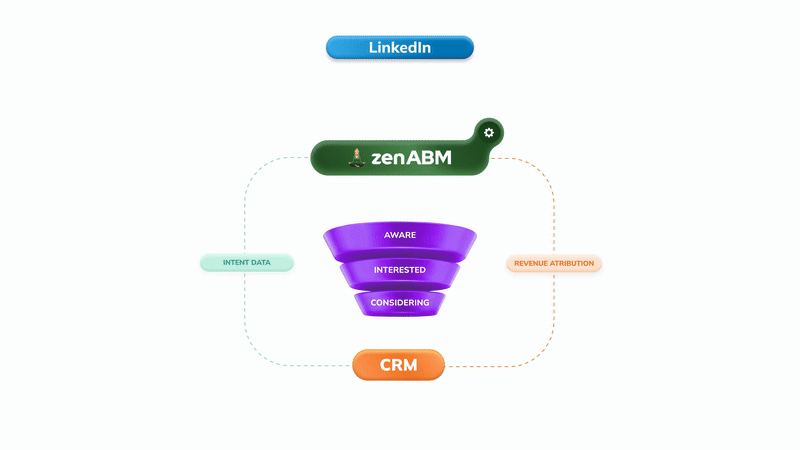
N.Rich vs. LinkedScope: Quick Summary
In case you’re short on time, here is the snapshot:
- N.Rich is an intent-driven ABM execution platform on top of a B2B DSP, built for mid-market and enterprise teams that want ICP lists, programmatic campaigns, and account-level attribution.
- LinkedScope is a LinkedIn-centric attribution and optimization layer that focuses on company and job title reach, engagement, and pipeline impact from LinkedIn Ads.
- N.Rich is better when you need dynamic ICP building, consent-based intent, programmatic plus LinkedIn, and opportunity attribution in one ABM engine.
- LinkedScope fits teams that already spend heavily on LinkedIn and want clearer company-level reporting, intent scoring, and CRM tied attribution without a full DSP stack.
- Pricing for N.Rich is clearly in five-figure territory per year, while LinkedScope pricing is opaque and not backed by public reviews.
- A third option: ZenABM gives account-level LinkedIn ad engagement, engagement to pipeline dashboards, account scoring, ABM stages, CRM sync, first-party qualitative intent, automated BDR assignment, custom webhooks, an AI chatbot, and job title level engagement tracking, starting at $59 per month.
N.Rich Overview: Key Features, Pricing, and Reviews
N.Rich presents itself as an agile ABM execution layer for mid-market and enterprise teams, built on top of a B2B DSP with intent, ICP, and ABM workflows.
Key Features of N.Rich
Core N.Rich capabilities for ABM include ICP building, intent scoring, programmatic campaigns, and account-level analytics.
Dynamic ICP & Target Account Lists
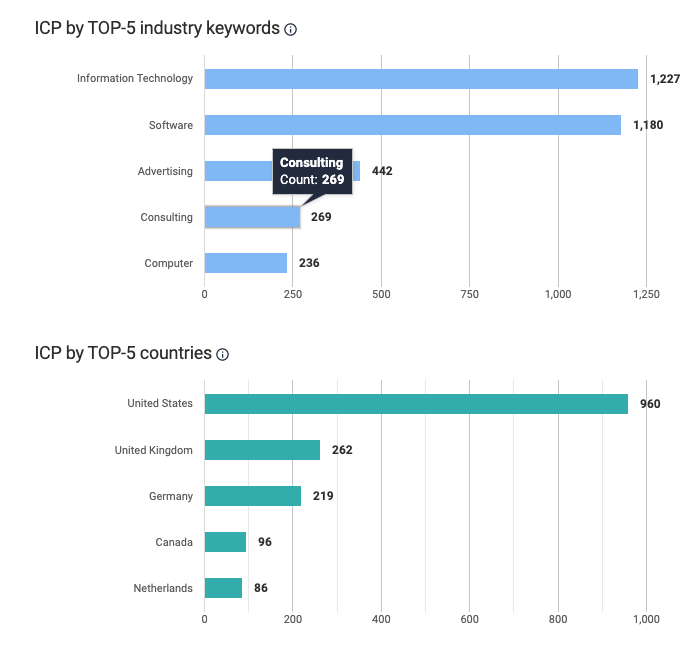
N.Rich pulls in CRM opportunity data to learn what your best customers look like, then scores new accounts against that pattern. Target lists can be built quickly using filters such as industry, employee count, and tech stack.
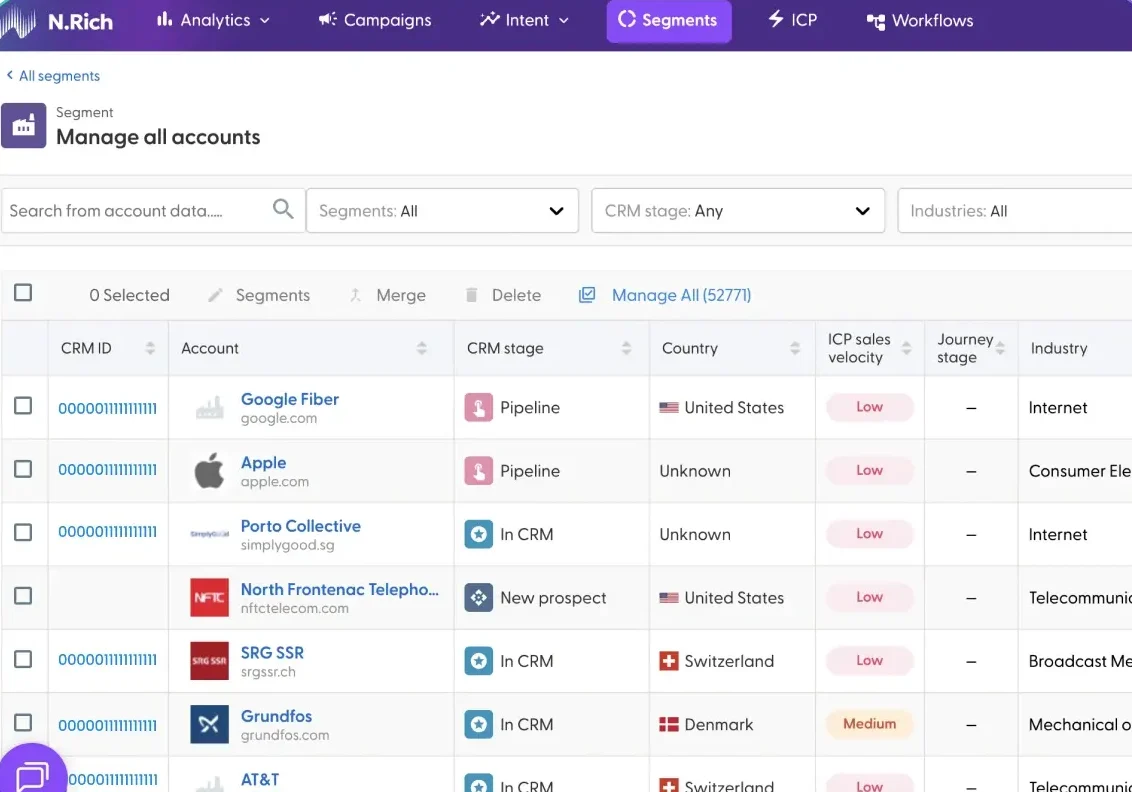
The idea is to move beyond gut feel account picks, although results still depend on CRM data quality.
Intent Data & Account Scoring
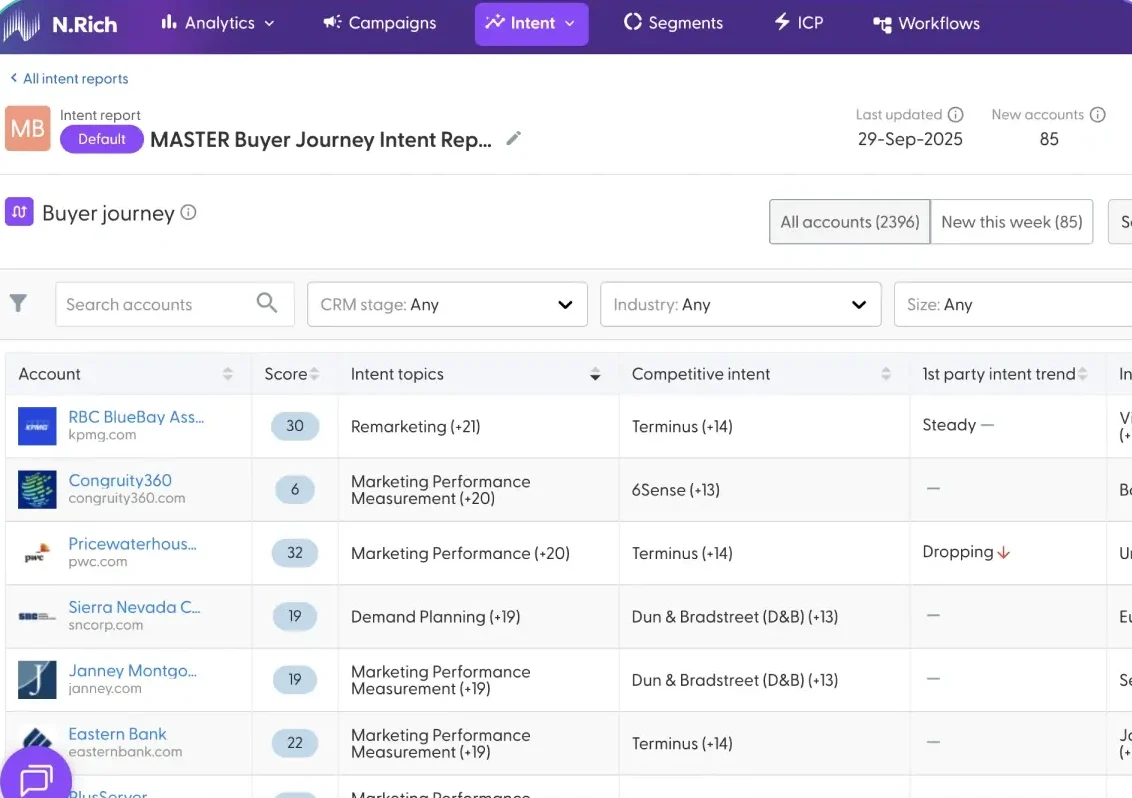
N.Rich blends first-party signals (site visits, ad engagement) with third-party intent feeds to highlight accounts researching key topics.
Accounts receive intent scores so sales and marketing can focus on those showing the strongest, consent-based interest, while topic data syncs into your CRM.
Account-Based Advertising
N.Rich ships with a built-in DSP to run programmatic display to target accounts, supporting native and video formats.
You can connect LinkedIn Ads to keep display and LinkedIn campaigns aligned, and reviewers note a simple campaign builder with bulk creatives and A/B tests.
Analytics & Opportunity Attribution
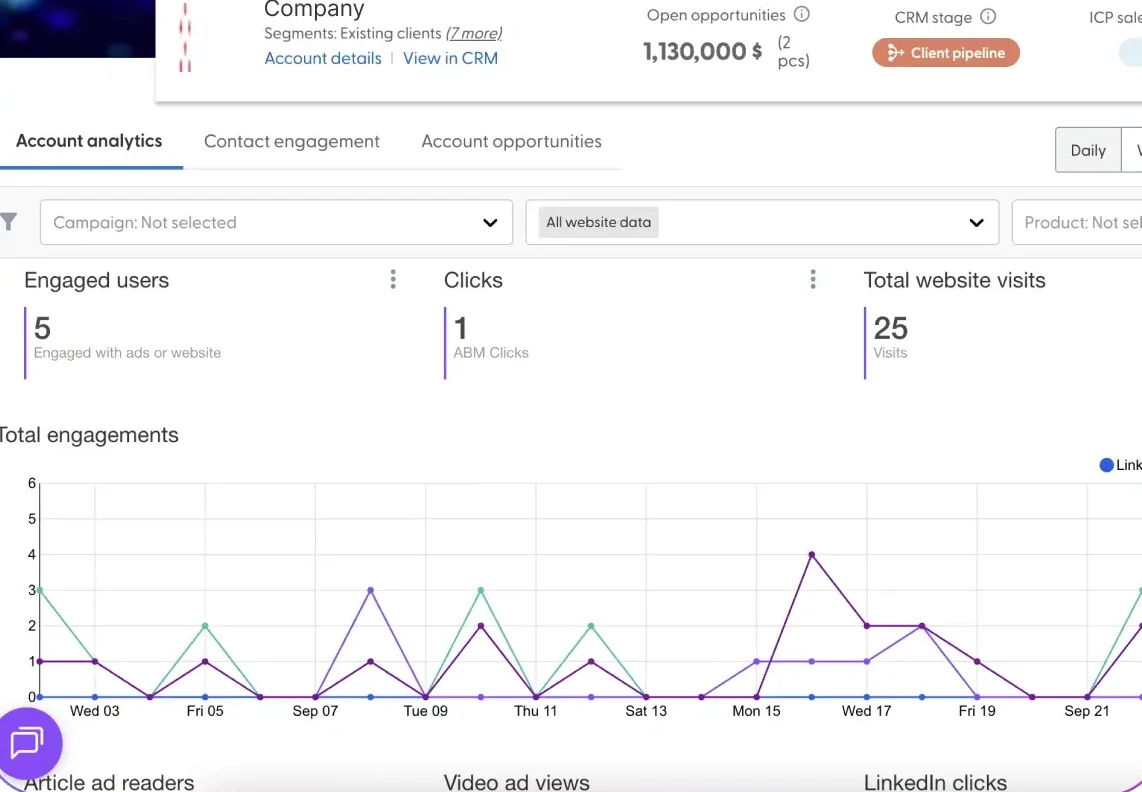
N.Rich provides account-level analytics so you can see how engagement connects to pipeline and revenue. Its Opportunity Attribution dashboard links impressions, clicks, and visits with opportunities and closed deals.
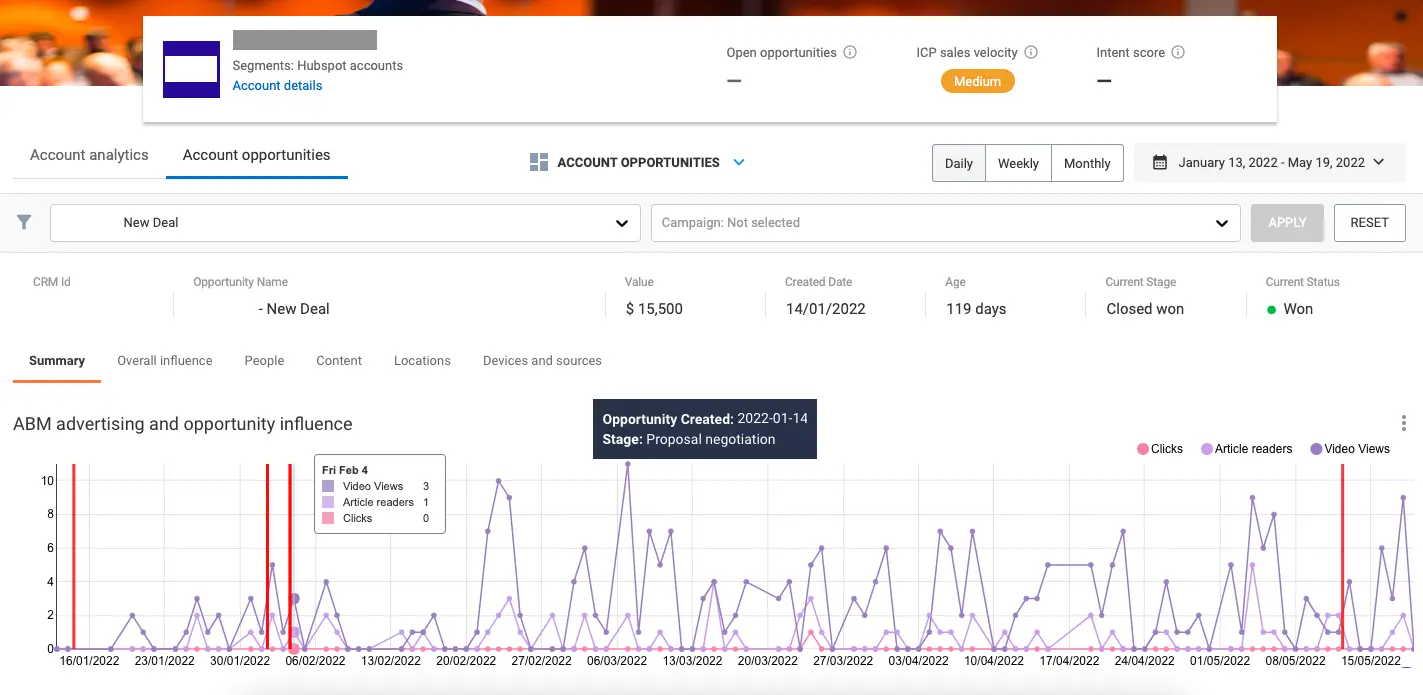

The system also calculates an ICP Sales Velocity Score for each account, with data sync back to the CRM on higher tiers.
Integrations & Data Enrichment
N.Rich integrates with the main CRMs and marketing tools. Native connectors exist for Salesforce, HubSpot (Marketing and Sales Hub), and LinkedIn (Marketing Solutions and Sales Navigator), letting you pull CRM data for segmentation and push back engagement, topics, and scores. Higher tiers add firmographic and technographic enrichment.
N.Rich Pricing: How Much Does It Cost?

N.Rich has tiered pricing tied to team size and ABM maturity. All plans aim to turn intent data into deals.
LITE: Starting at $10,320/year + $1,050 One-Time Onboarding Fee
For smaller teams starting with intent-driven ABM.
Includes 1 intent report, 10 topics, 1 marketing seat, 3 sales seats, 1 N.Rich account, 1 ABM campaign, chat support, plus:
- Intent scoring
- Unlimited firmographic and technographic data
- Website visitor identification
- Basic account analytics and alerts
GROWTH: Starting at $23,800/year
For teams scaling ABM and needing closer sales and marketing alignment.
Includes everything in LITE plus:
- More intent reports and topics
- More marketing seats and unlimited sales seats
- CRM and MAP integrations
- Opportunity attribution and more ABM campaigns
- Dedicated Customer Success Manager
ENTERPRISE: Custom Pricing
For global, mature ABM programs with advanced orchestration needs.
Includes everything in GROWTH plus:
- Unlimited intent reports and higher topic limits
- Unlimited users and multiple N.Rich accounts
- Dynamic ICP Builder and open API
- Automated workflows and strategic consulting
All plans benefit from N.Rich’s data depth and native ABM orchestration, but you still need to talk to sales for exact quotes.
Note: because N.Rich starts above $10K per year, ZenABM often looks leaner for LinkedIn first teams, starting at ~$59/month, with the top tier still under $6K per year. You still get core LinkedIn ABM essentials: account-level ad engagement tracking, account scoring, ABM stage tracking, hot account routing, bi-directional CRM sync, custom webhooks, qualitative intent, and plug-and-play ROI dashboards.

User Impressions and Reviews
N.Rich scores 4.7 out of 5 on G2 (around 99 reviews), which suggests customers are broadly satisfied.
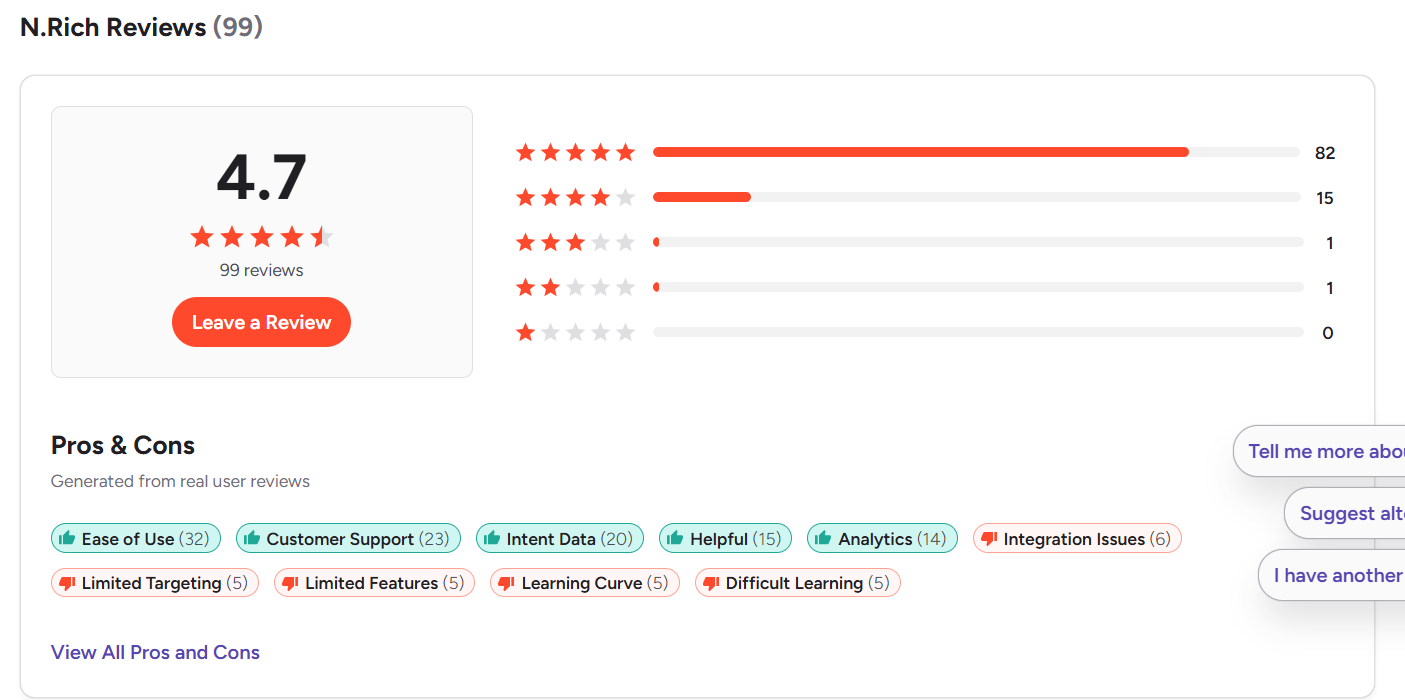
Across G2, TrustRadius, Reddit, and similar sources, a few themes show up.
Pros (According to Users)
- Support that shows up: Reviewers often describe N.Rich’s support as responsive and proactive, with regular check ins that are not just upsells.
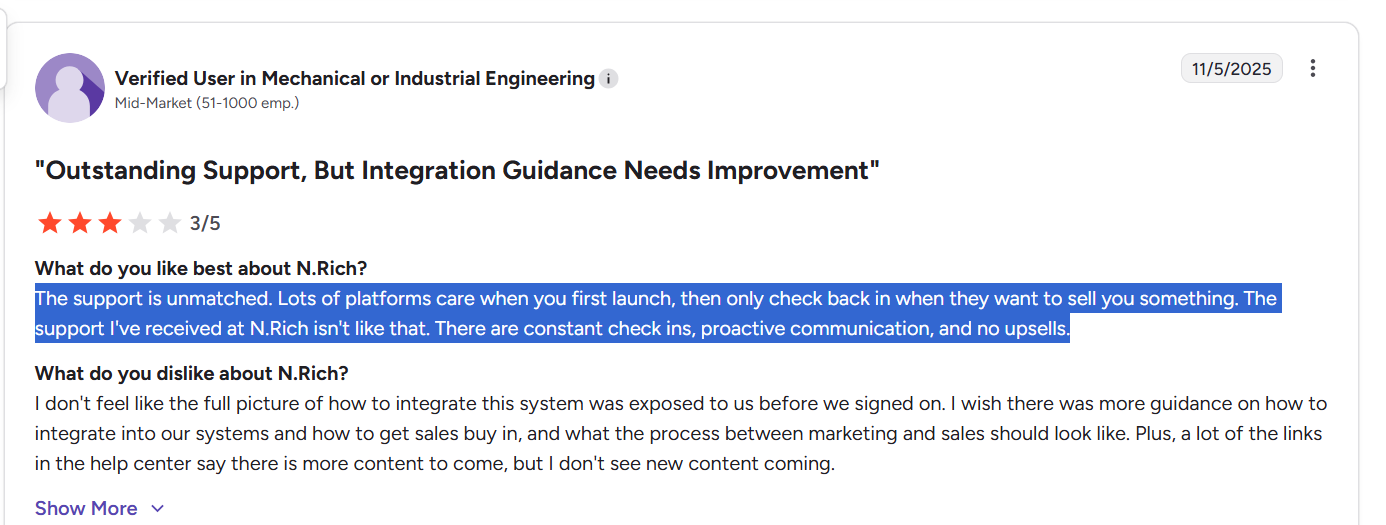
- Usable once configured: Many call it easy and even “fun” to use once lists, reports, and campaigns are in place.
- Strong intent and targeting: Users praise the quality of intent and account selection for focusing ad spend on high-value accounts.
Cons (According to Users)
- Setup takes work: Onboarding, data mapping, and reporting usually need ops involvement.
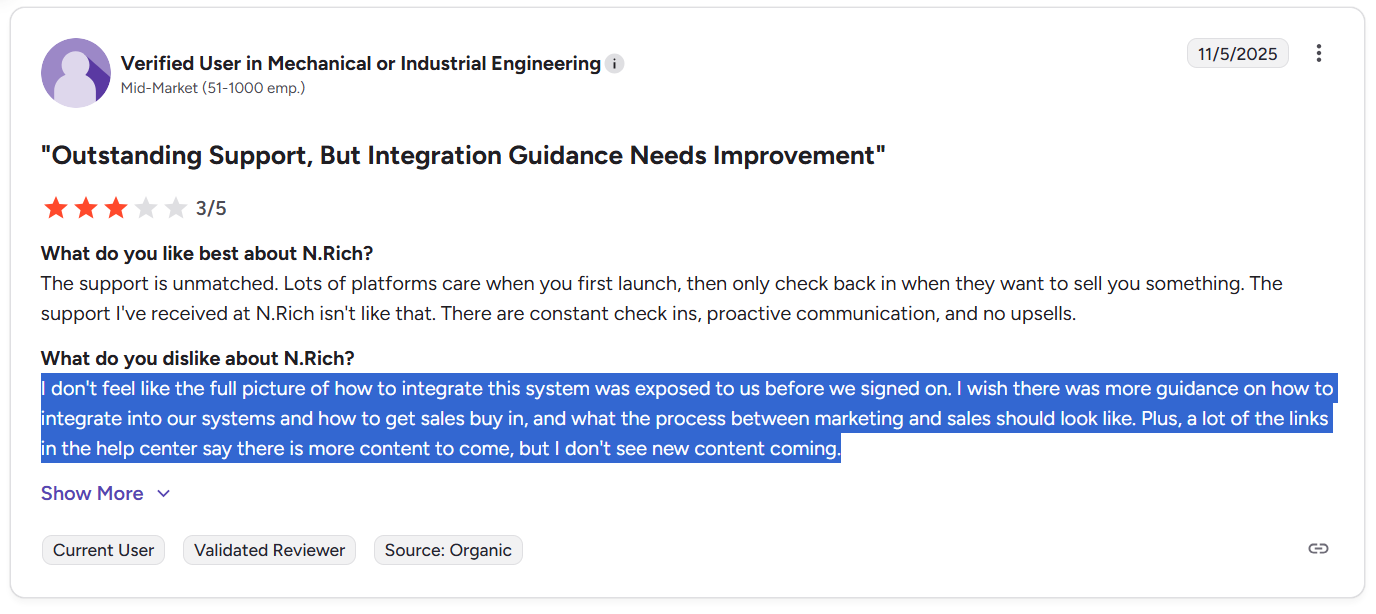
- Integrations need clearer guidance: Some reviewers report integration surprises and wish the full picture had been clearer before signing.
- Feature gaps: A few users mention limits around ad copy, session timeouts, or glitches.
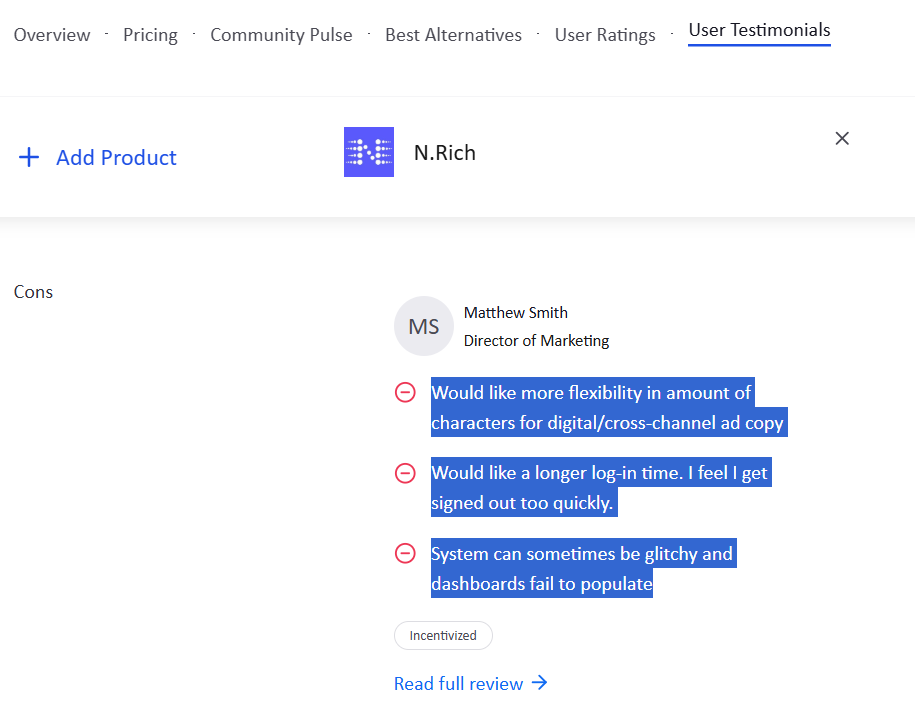
LinkedScope Overview: Key Features, Pricing, and Reviews
LinkedScope markets itself as a LinkedIn-centric account-based marketing attribution and optimization platform.
Let’s take a deeper look at its features and see its pricing and user reviews.
Key Features of LinkedScope
LinkedScope is essentially a LinkedIn Ads analytics layer + CRM connector with a sprinkling of intent scoring. I
It promises to tell you exactly which companies your LinkedIn ads reached, how they engaged, and whether they turned into pipeline or deals.
It even cooks up weekly prospect lists (accounts with high engagement metrics), so sales can pursue the most interested leads.
Let’s take a closer look at its core features:
LinkedIn Ad Targeting & Reporting
It taps LinkedIn’s official API to pull all the company names and job titles exposed to your ads (no 25-title cap like Campaign Manager).

You can build target-account lists in LinkedScope and auto-sync them into LinkedIn campaigns in real time.
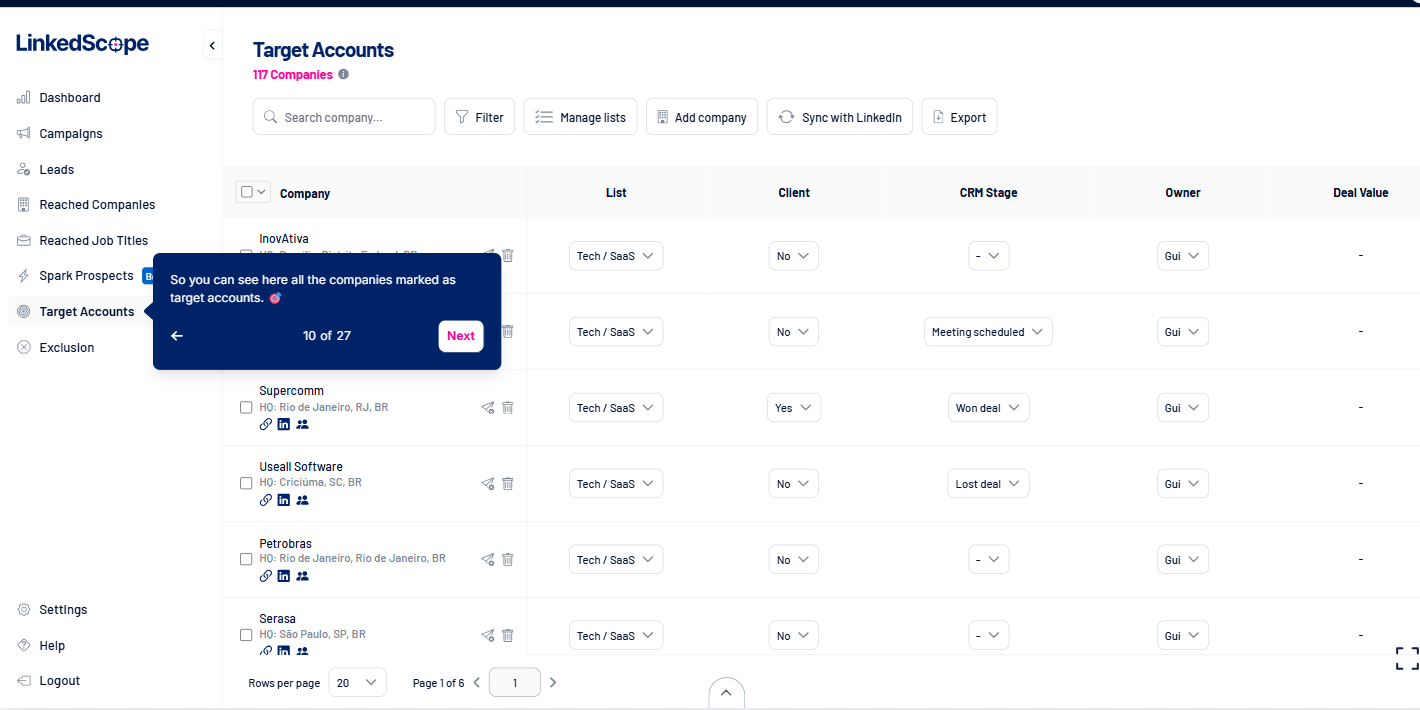
You also get dashboards for campaign reach, company penetration, and (via LinkedIn API) post-click engagement.

First-Party Data & Intent Scoring
All data comes straight from your LinkedIn ad campaigns via the official API.
LinkedScope does not invent third-party insights.
Because of LinkedIn’s rules, it only shows you analytics that LinkedIn itself has, just presented more fully.
On top of raw stats, it computes a proprietary Intent Index: basically an engagement score (clicks, conversions, comments, etc.) to highlight “Spark Prospects.”
Sales reps supposedly get a prioritized list of accounts already warmed up by ads.
CRM Sync & Attribution
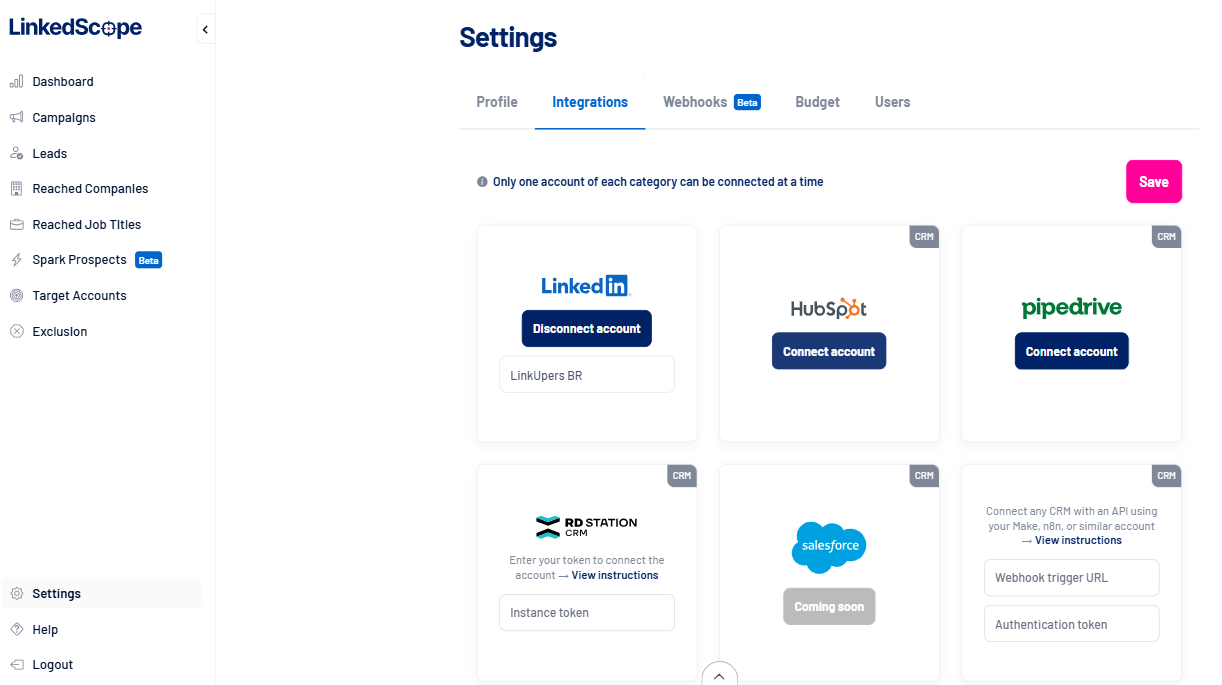
LinkedScope matches the companies hit by your ads to deals in any CRM (HubSpot, Pipedrive, RD Station, Salesforce, etc.).
It does this by matching website domains or exact company names.
This lets you attribute revenue to LinkedIn Ads: e.g. “$8M in closed deals came from accounts we had advertised to,” as their case study graphic brags.
Essentially, LinkedScope shifts LinkedIn Ads analytics from top-of-funnel vanity into supposed bottom-line visibility.
It also pushes the LinkedIn reach/intent data into tools like Slack or Zapier via webhooks, so you can automate alerts or import lists of engaged accounts into other systems.
By the way, ZenABM also provides detailed plug-and-play account-based LinkedIn ad revenue attribution dashboards for a starting price of just $59/month.
It does that by matching ad-engaged companies to the deals in your CRM, just like LinkedScope.
But there’s a difference: ZenABM doesn’t just match website domains to exact company names, but uses advanced algorithms to ensure minor spelling differences, etc., don’t leave companies unmatched.
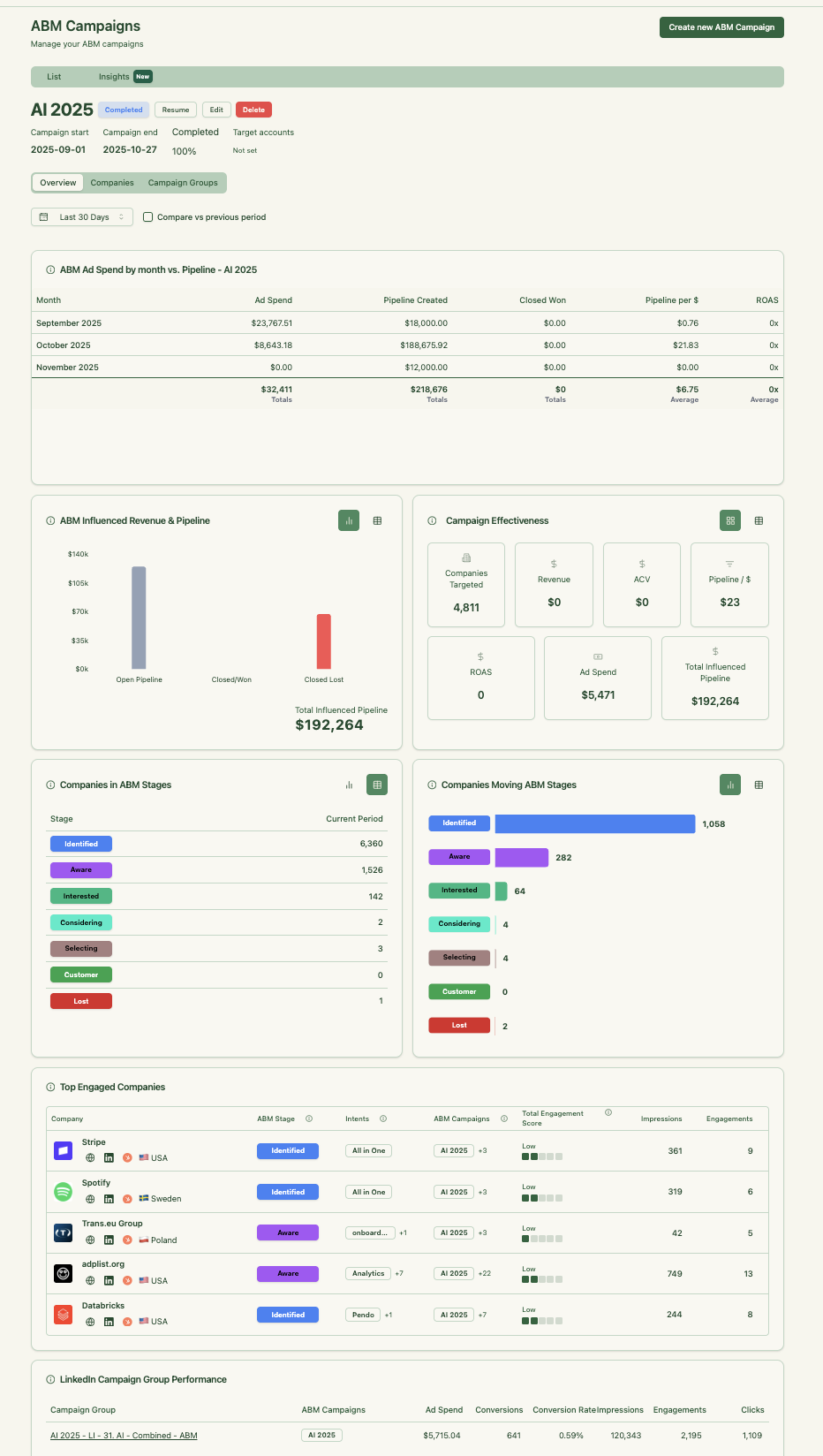
LinkedScope Pricing: How Much Does It Cost?
LinkedScope’s site doesn’t mention anything except the fact that the subscription is month-to-month with no contract, and you get a 15-day free trial with no credit card.
Since many enterprise ABM tools (Demandbase, 6sense, Terminus, etc.) run into the tens of thousands per year, it’s fair to wonder where LinkedScope sits on the spectrum.
My guess: it’s probably priced for mid-market marketers or agencies who spend heavily on LinkedIn. If it were dirt-cheap or free, I doubt they’d omit it so pointedly.
In lieu of official rates, I checked the usual place: G2.
No luck there either.
LinkedScope has zero reviews on G2 and no user-submitted pricing.
Reddit and TrustRadius turned up nothing either.
In short, there’s no independent word on what it costs or whether any budget-conscious marketer ever questioned the bill.
If you are looking for a leaner yet effective tool, I present ZenABM, starting at just $59/month.
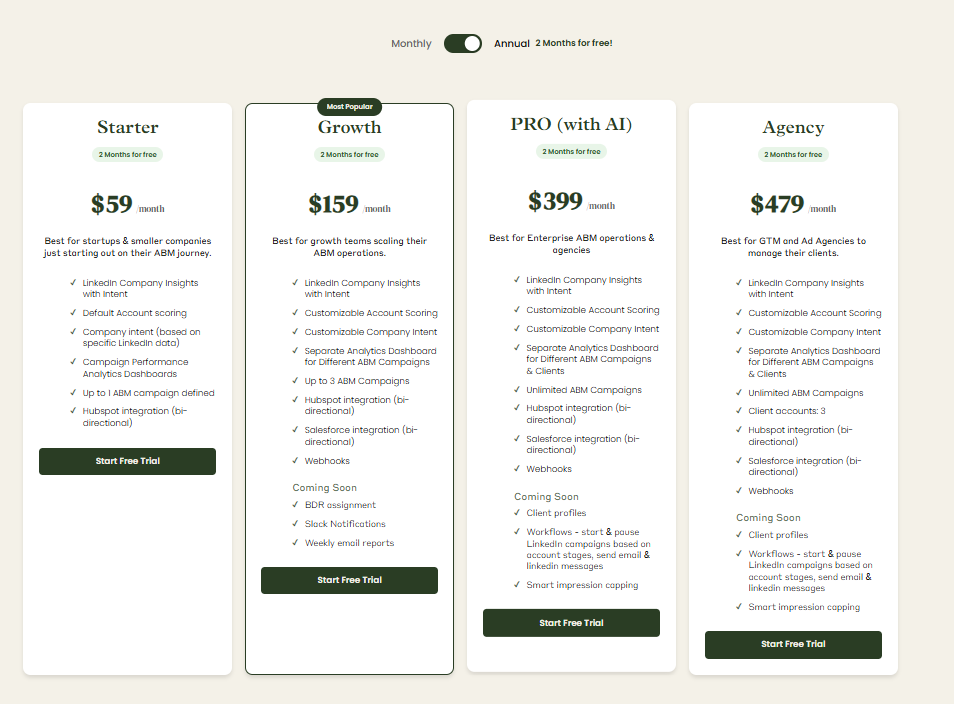
ZenABM offers account-level LinkedIn ad engagement tracking, ad engagement-to-pipeline analytics with plug-and-play dashboards, account scoring, ABM stage tracking, CRM sync, first-party qualitative intent data, automated assignment of BDRs to high-priority accounts, custom webhooks, an AI chatbot, impression capping, ABM objects, and ad engagement tracking at the job title level.

User Impressions and Reviews
It’s hard to analyze user sentiment when nobody’s talking.
As of now (late 2025), the only feedback I found on LinkedScope is marketing testimonials in Portuguese/Spanish on their site.
No one on Reddit or LinkedIn has posted a “I love/hate LinkedScope” rant that I could find.
G2 explicitly notes that there are not enough reviews to give any insight.
N.Rich vs. LinkedScope: Key Differences
The key differences between N.Rich vs. LinkedScope are tabulated here.
| Feature category | N.Rich | LinkedScope | Where ZenABM fits |
|---|---|---|---|
| Core positioning | ABM execution platform built on a B2B DSP with ICP builder, intent, and programmatic plus LinkedIn campaigns | LinkedIn Ads analytics and attribution layer focused on company and job title reach and engagement | LinkedIn first ABM analytics and routing layer that can complement either tool |
| Primary focus | Turn consent based intent and CRM data into targeted ads and measurable opportunities | Show which companies saw LinkedIn ads, how they engaged, and how that connects to the pipeline and deals | Reveal which companies engage with LinkedIn ads and how that drives ABM stages and revenue |
| Main capabilities | Dynamic ICP builder, target lists, intent scoring, ABM campaigns, account analytics, opportunity attribution | Company and job title reach, engagement dashboards, intent index, prospect lists, CRM and webhook attribution | Company-level engagement, ABM stages, account scoring, CRM sync, intent tagging, ROI dashboards, AI chatbot |
| Channels covered | Programmatic display via built in DSP plus coordination with LinkedIn Ads | LinkedIn Ads as the primary channel, with focus on analytics and revenue attribution | LinkedIn Ads only, treated as the main ABM channel |
| Intent model | Mix of first party engagement and third party intent topics, tracked in a consent based way | First party engagement and reach data sourced from the LinkedIn Ads API with a proprietary intent index | First party qualitative intent based on how companies interact with themed LinkedIn campaigns |
| Account analytics and attribution | Account level analytics with opportunity attribution and ICP sales velocity scores | Company level views of reach and engagement tied to CRM opportunities and closed deals | ABM dashboards that show account movement by stage, pipeline per dollar, and ROAS for LinkedIn campaigns |
| Integrations | Salesforce, HubSpot, LinkedIn Marketing Solutions and Sales Navigator, plus enrichment on higher tiers | CRM integrations such as HubSpot, Salesforce, Pipedrive and others, plus Slack and Zapier via webhooks | Bi directional HubSpot sync, Salesforce on higher plans, and flexible webhooks into the rest of the stack |
| Pricing profile | Tiered plans starting above ten thousand dollars per year, plus onboarding and scaling with usage | Ongoing subscription with month-to-month terms, but no public pricing or independent benchmarks | Starts at $59 per month, with the top plan still under $6k per year |
| Ideal team profile | Mid-market and enterprise teams that want intent-driven programmatic plus LinkedIn with clear attribution | Teams that invest heavily in LinkedIn Ads and want deeper company-level analytics and revenue proof | LinkedIn first ABM team and agency that needs company-level engagement, stages, and routing on a lean budget |
| Where ZenABM fits | Acts as a LinkedIn analytics and intent companion when N.Rich runs the broader ABM and programmatic motion | Acts as a deeper ABM layer when you outgrow basic LinkedScope reporting and need stages and scoring in the CRM | Can serve as the primary ABM platform when LinkedIn is the central growth channel |
N.Rich vs. LinkedScope: So Which Is Better for ABM?
N.Rich is usually the better choice if your ABM motion already assumes intent topics, dynamic ICPs, and a mix of programmatic display plus LinkedIn. It pulls CRM opportunity data into an ICP builder, scores accounts by fit and intent, runs targeted campaigns, and then closes the loop with opportunity attribution and sales velocity. If you want one execution layer that turns intent into ads and ads into opportunities, N.Rich fits that job.
LinkedScope is a better fit if your paid motion is almost entirely LinkedIn and your main pain is not execution but visibility. It leans into LinkedIn API data to show which companies and job titles saw your ads, how they engaged, and how that maps to CRM deals. For teams that want to prove LinkedIn ROI and feed engaged accounts to sales without adopting a full ABM suite, LinkedScope is the more minimal option.
ZenABM as a LinkedIn First, First Party Lean ABM Alternative
If you mostly need first-party accuracy on LinkedIn, account scoring, ABM stages, CRM sync, and revenue attribution, a lighter option makes more sense.
This is where ZenABM comes in.
In fact, even for teams running heavy mult-channel ABM campaigns, ZenABM is valuable due to its following unique features:
Account-Level LinkedIn Engagement Tracking


ZenABM connects directly to the official LinkedIn Ads API and records account-level data for every campaign.
You see which companies view and engage with your ads using first-party LinkedIn data instead of noisy IP or cookie matching. A Syft study suggests IP identification accuracy peaks around 42 percent, which is why ZenABM treats ad engagement as the primary intent signal.
Real Time Engagement Scoring & ABM Stages

ZenABM updates engagement scores continuously as accounts interact with your ads. The interface shows a full touchpoint history and lets you define custom stages such as Identified, Aware, Engaged, Interested, and Opportunity.


CRM Integration and Workflows
ZenABM syncs bi-directionally with HubSpot and adds Salesforce support on higher plans. All LinkedIn metrics can be written as company properties in your CRM.
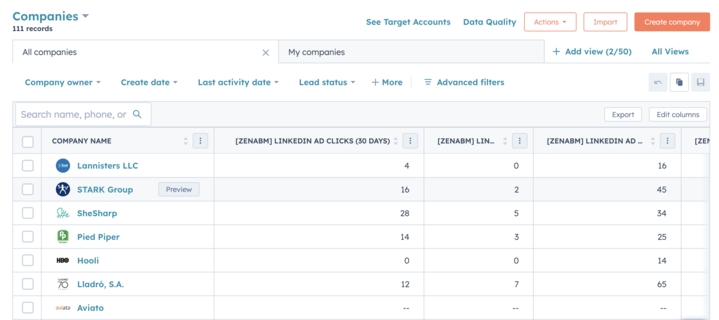
When an account crosses your score threshold, ZenABM updates the stage and can assign a BDR automatically.

Intent Tagging and ABM Analytics
ZenABM lets you pull intent topics from LinkedIn campaigns and tag each campaign by feature, use case, or offer.
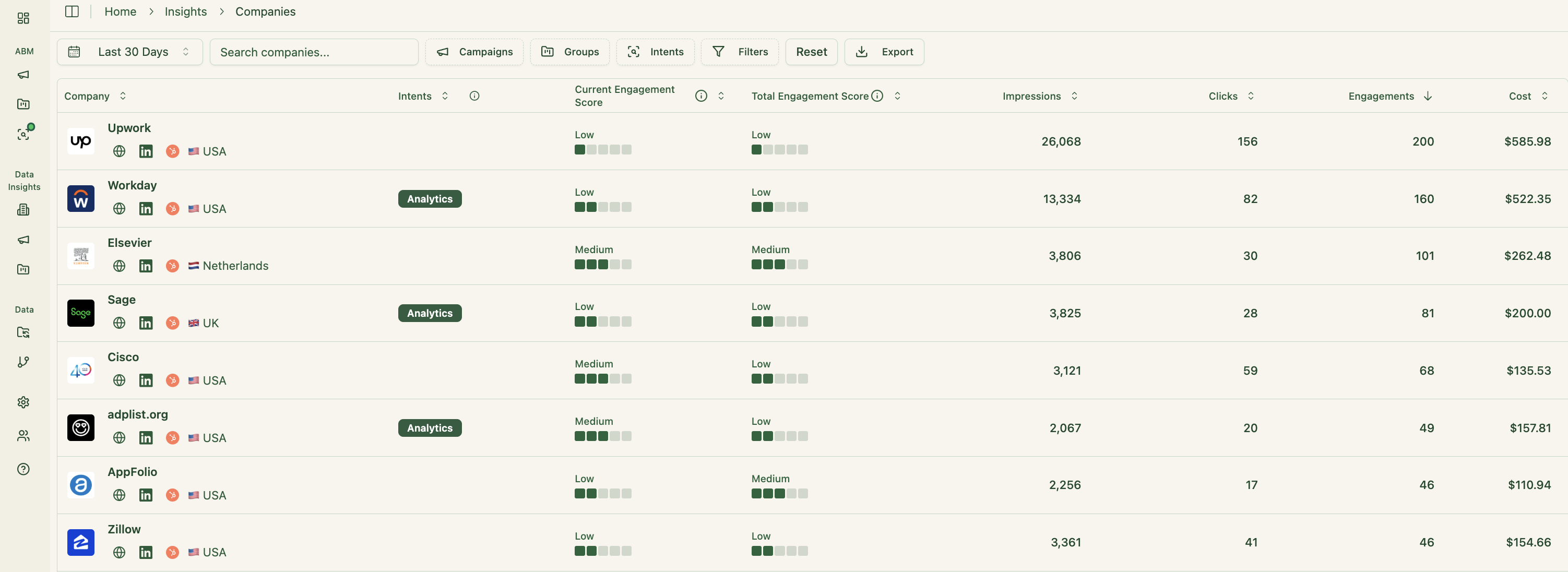
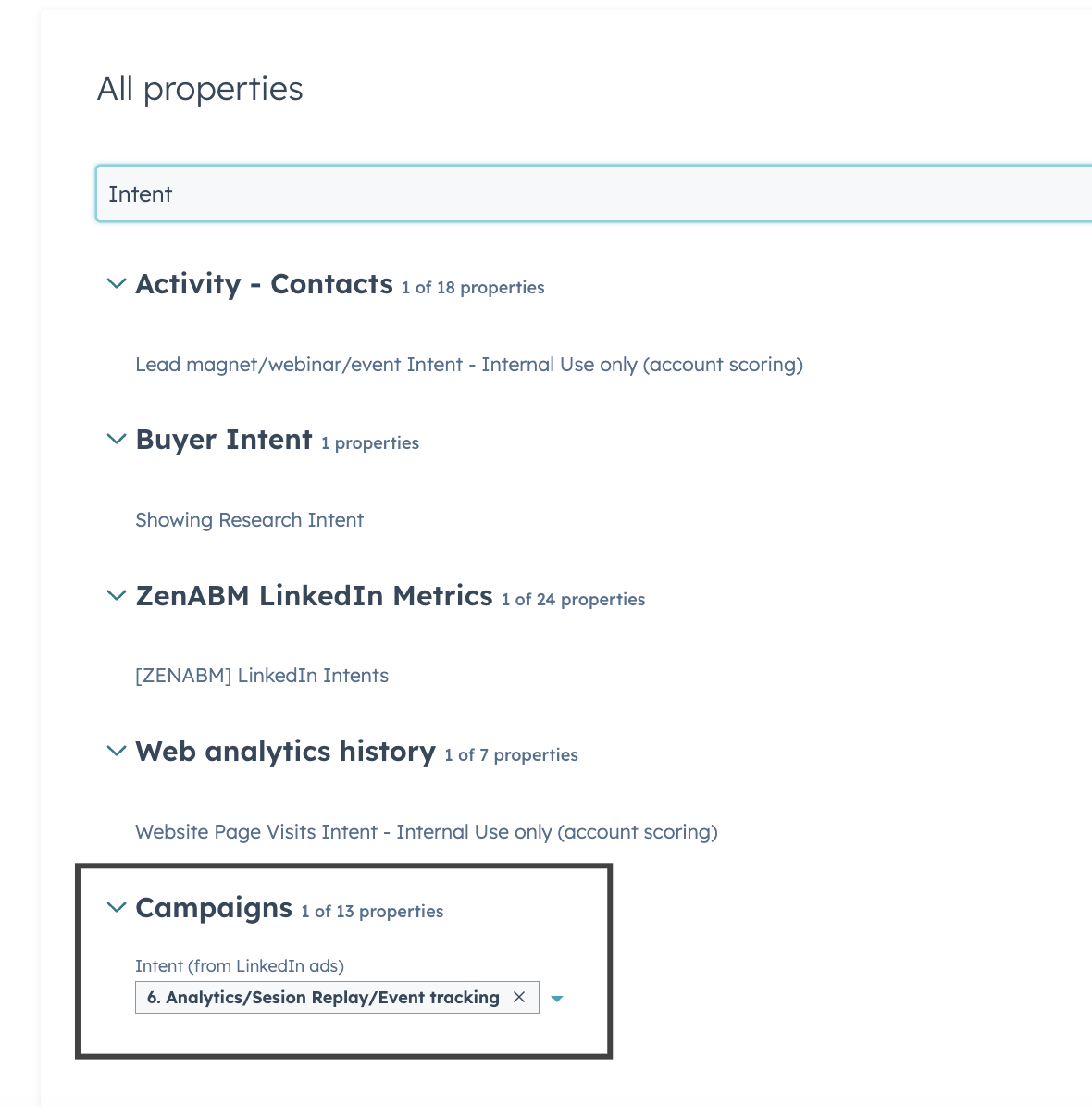
ZenABM includes ABM dashboards that tie LinkedIn ads to account engagement, stages, and revenue. You can see performance from ABM initiatives down to campaign groups and individual ads, and because ZenABM stores deal value and ad spend per company and campaign, it calculates ROAS and pipeline per dollar.
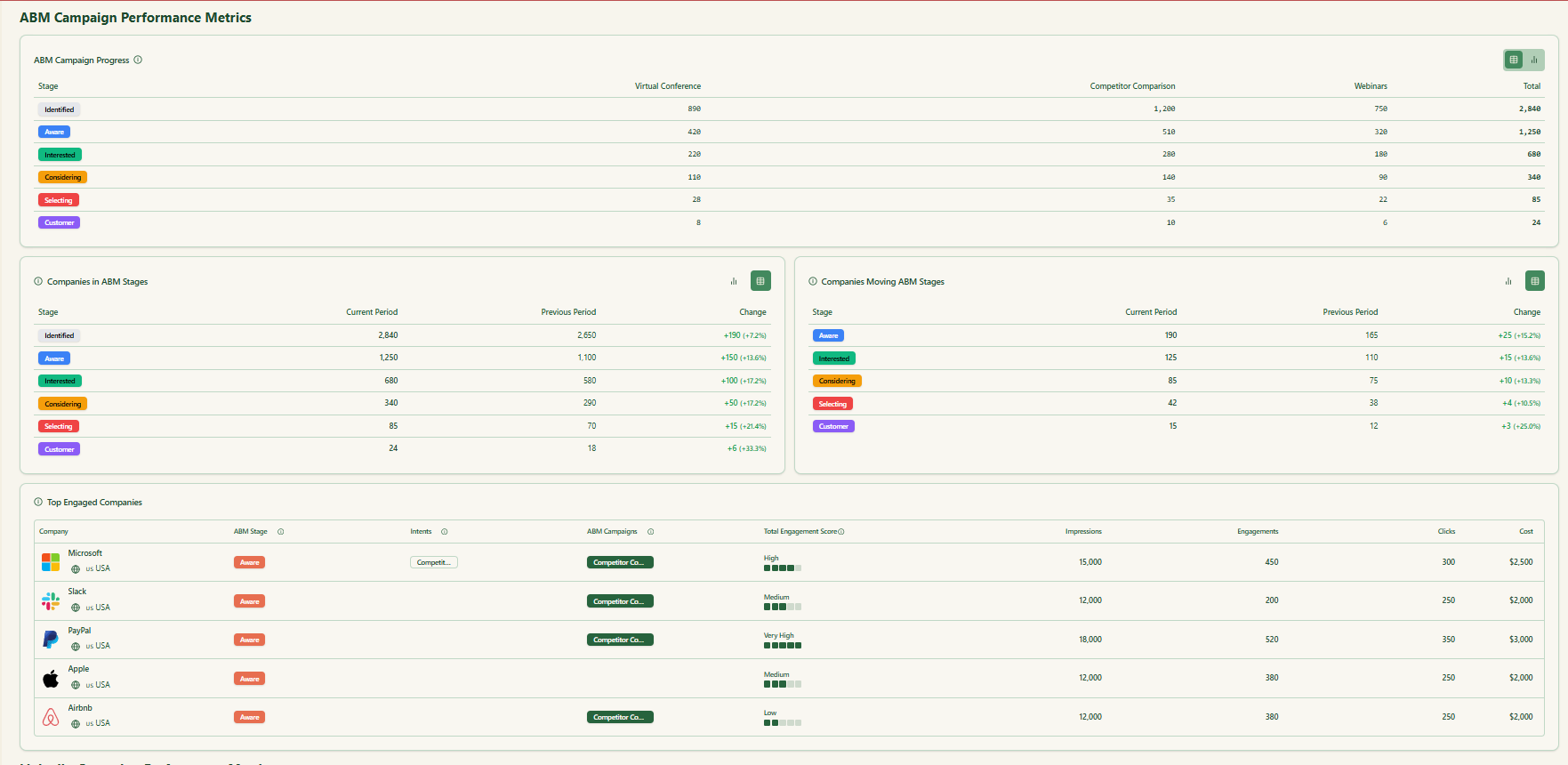

Webhooks, Job Title Analytics & Campaign Objects
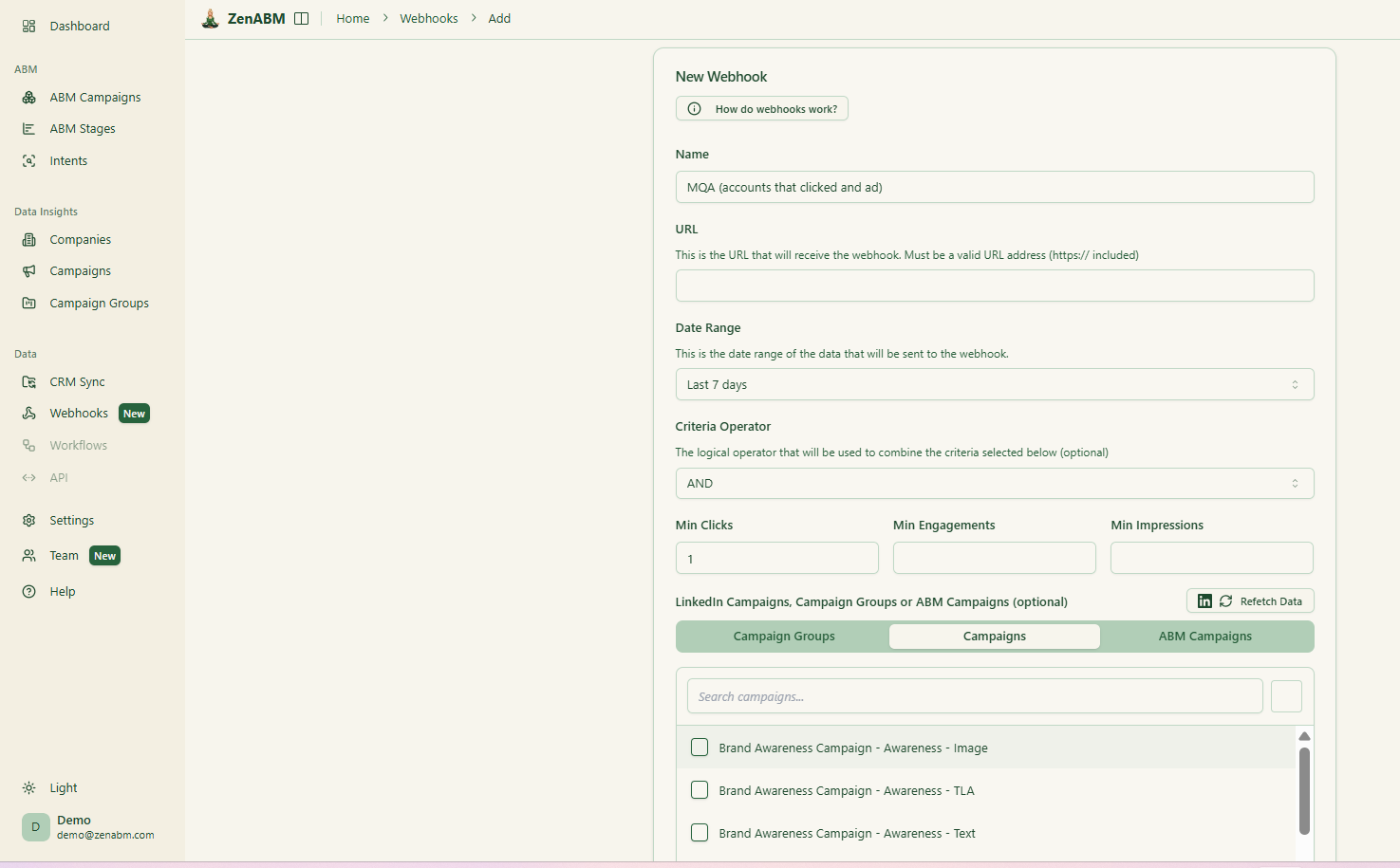
ZenABM webhooks send events into your stack for Slack alerts, enrichment flows, and other automation.
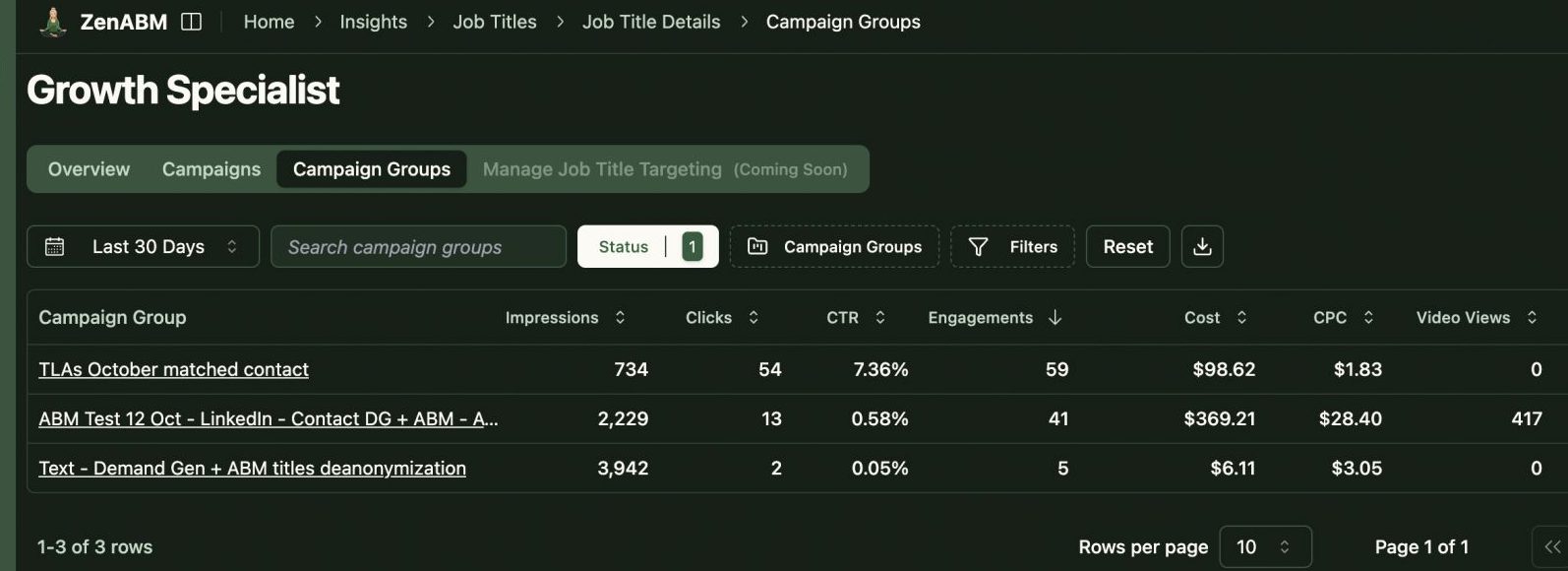
You can also group LinkedIn campaigns into ABM campaign objects to view performance across markets, personas, or creative clusters instead of juggling isolated reports.
AI Chatbot & Multi Client Workspace
ZenABM includes an AI chatbot on top of your LinkedIn API data and ABM model so you can ask questions like “Which accounts moved from Interested to Selecting last month?” or “What is my pipeline per dollar on retargeting campaigns?”.
It also supports agencies via a multi-client workspace, so you can manage several ad accounts and clients with separate ABM campaigns, dashboards, and reporting without constant account switching in Campaign Manager.
ZenABM Pricing

Plans start at $59/month for Starter, $159/month for Growth, $399/month for Pro (AI), and $479/month for Agency.
Even the agency plan stays under $6,000 per year, with all tiers including core LinkedIn ABM capabilities.
Higher tiers mainly raise limits and add Salesforce sync. All plans include a 37-day trial period.
Conclusion
N.Rich and LinkedScope both try to solve the same broad problem, which is proving that your paid efforts actually move accounts and revenue, but they attack it from different angles.
N.Rich is an intent-driven ABM execution engine wrapped around a DSP. It excels when you want to push consent-based intent and CRM insights into programmatic and LinkedIn campaigns, then measure how those programs convert into opportunities and deals.
LinkedScope is more of a LinkedIn microscope. It taps LinkedIn’s API to expose which companies and job titles saw and engaged with your ads and connects that activity to CRM opportunities.
For teams already all in on LinkedIn who just need cleaner analytics and attribution rather than another heavy platform to run, that is attractive.
Neither tool is a clear winner in every scenario.
If you have a mature multichannel ABM program and budgets to match, N.Rich makes sense as your primary execution layer.
If your spend is concentrated on LinkedIn and you mainly want to identify engaged accounts and prove pipeline impact from that one channel, LinkedScope is more aligned with your reality.
For LinkedIn-first teams that care less about running programmatic and more about first-party accuracy, ABM stages, CRM sync, and dollar-level attribution, ZenABM is often the simpler and cheaper answer. It gives you company-level LinkedIn intent, routing, and revenue views at a fraction of typical ABM suite prices and can easily sit beside either N. Rich or LinkedScope, if you decide to keep them in your stack.



